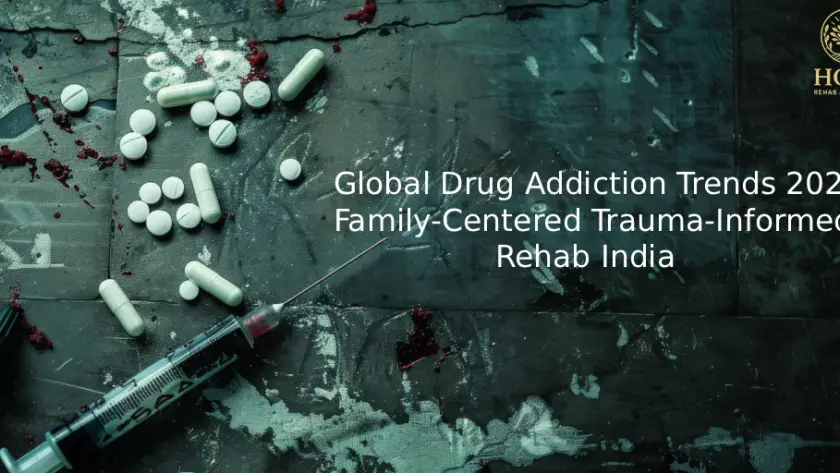Drug markets and patterns of misuse shifted significantly in 2023–2025, with rising stimulant use in Europe and the Americas, persistent opioid and tramadol misuse in parts of the Middle East, and a continued burden of alcohol and cannabis in India and the USA. Understanding regional differences — and the trauma and family harm that lie behind them — is essential for designing effective, trauma‑informed rehabilitation programmes. This article summarises the most recent international evidence and outlines a patient‑centred model of care offered at Hope Rehab & Wellness, Delhi.
Drug trends in the United Kingdom
The UK continues to report high and rising rates of stimulant use — notably cocaine and ketamine — alongside widespread cannabis consumption. The Office for National Statistics and NHS data show increased treatment demand, rising hospital admissions related to stimulants, and growing concerns about the mental‑health consequences of chronic ketamine exposure. Families commonly report secrecy, financial strain and relational breakdowns when a member develops problematic stimulant or cannabis use.
Drug trends in the United States
In the United States, polysubstance patterns include alcohol, prescription opioid misuse (including tramadol in some regions), and a continuing rise in synthetic drugs and cocaine in certain urban markets. National surveys and NIDA reports emphasise that medication‑assisted treatment and integrated mental‑health services are critical components of effective care. Community and family impacts are profound: untreated addiction contributes to family breakdown, child neglect and long‑term socioeconomic consequences.
Drug and alcohol trends in India
India faces a complex and growing substance‑use challenge: alcohol remains the most commonly used psychoactive substance, while opioids, cannabis, and increasingly synthetic drugs contribute to regional epidemics. National surveys and task‑force reports note substantial treatment gaps — with many people never accessing evidence‑based care. Policy discussions in 2024–2025 highlight the need to shift emphasis from criminalization to care and rehabilitation.
Drug trends in the Middle East and Eastern Mediterranean
The Eastern Mediterranean region faces a distinct profile: Captagon (fenethylline) seizures and amphetamine‑type stimulant availability have surged, tramadol misuse is widespread in several countries, and traditional stimulants such as khat persist in parts of the region. These patterns occur in the context of political instability, displacement and trauma, intensifying family and community harms.
Trauma and addiction: the hidden engine
Robust evidence links adverse childhood experiences, conflict exposure and chronic stress with elevated risk for substance use disorders. Trauma alters neurobiological reward circuits and stress responsivity, increasing the likelihood that individuals will use substances to self‑medicate. Clinical programmes that ignore trauma are more likely to see relapse; conversely, trauma‑informed therapies reduce symptom burden and improve retention in care.
How addiction devastates families
Addiction causes emotional insecurity, intergenerational trauma and financial distress within households. Children of parents with substance use disorders are at higher risk of neglect and mental‑health problems. Family‑centred rehabilitation restores relational safety through psychoeducation, structured family therapy and relapse‑prevention planning.
A trauma‑informed, family‑centred model of care: Hope Rehab & Wellness
Hope Rehab & Wellness employs an integrated pathway: comprehensive medical detox, trauma‑specific psychotherapies (EMDR, TF‑CBT), dual‑diagnosis psychiatric care, structured family therapy, and holistic modalities (yoga, nutrition, art therapy). Continuity of care and culturally competent practice underpin the centre’s approach, which serves international patients from the UK, USA, India and the Middle East.
Core, evidence‑based interventions
- Medical detoxification with 24/7 monitoring and thiamine replacement.
- Trauma‑focused psychotherapies (EMDR, TF‑CBT)
- Medication‑assisted treatment (where indicated) and psychiatric management.
- Family systems therapy and caregiver education.
- Holistic therapies for stress regulation and resilience building.
Cost & Access: India vs UK vs USA vs Middle East — an in‑depth comparison
Cost, availability and access to quality rehabilitation vary widely. The following comparison summarises typical ranges, access barriers, and system differences (figures are indicative and vary by provider, level of care and region).
India — Cost & Access
Typical private residential programme cost (30 days): USD 2,000–8,000 (range reflects basic to luxury offerings). Access: Increasing private sector capacity but persistent public treatment gaps and geographic inequity. Policy trend: shift towards treatment-oriented responses post-2023 national surveys.
United Kingdom — Cost & Access
Typical private residential programme cost (30 days): USD 6,000–20,000. Access: NHS provides publicly funded treatment with long waiting lists in some regions; private luxury rehab is available but costly. Recent ONS and NHS data show rising treatment entries and stimulant-related hospital admissions.
United States — Cost & Access
Typical private residential programme cost (30 days): USD 10,000–40,000. Access: Medicare/Medicaid coverage varies; evidence-based medication-assisted treatments are standard in many programs, yet overall treatment coverage remains inadequate relative to need. National surveys show large treatment gaps despite high prevalence.
Middle East — Cost & Access
Costs vary widely by country and facility—private programmes can be comparable to UK prices in GCC countries; in lower‑income states, access to quality rehabilitation is limited. Stigma, legal frameworks, and conflict reduce help-seeking, particularly for those affected by Captagon and tramadol misuse.
Choosing the right rehabilitation centre
Prioritise centres that offer: accredited medical and psychiatric staff; trauma‑informed and dual‑diagnosis capability; family therapy; transparent outcome measures; and culturally competent care for international patients. Confirm licensure and ask about relapse‑prevention and aftercare supports.
Conclusion — From Data to Compassionate Clinical Action
Global drug trends in 2025 underscore the need for regionally adapted, trauma‑informed, family‑centred rehabilitation. Hope Rehab & Wellness combines international best practice with culturally competent care to serve patients from the UK, USA, India and the Middle East. Healing requires medical safety, psychological depth, family repair, and sustained aftercare. With evidence‑based therapies and ethically run luxury facilities, recovery can be durable and life‑restoring.

